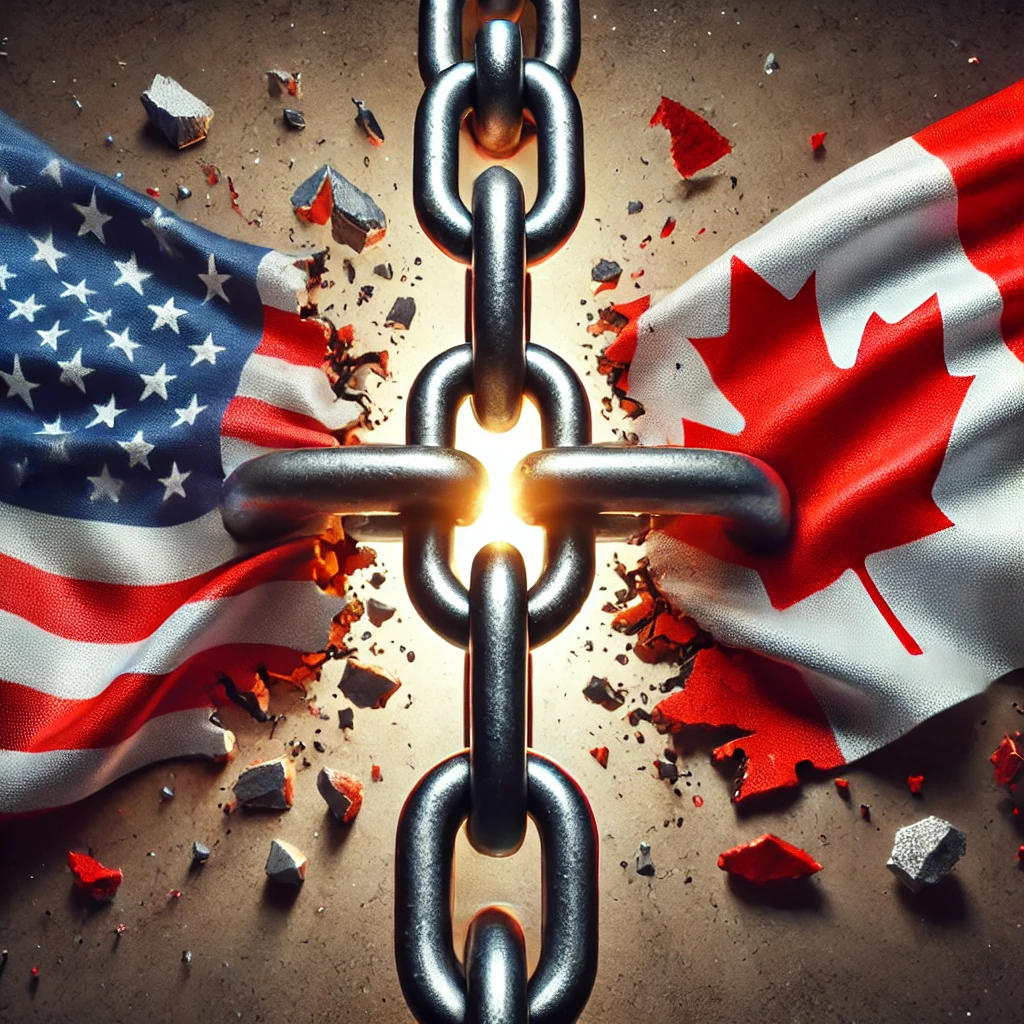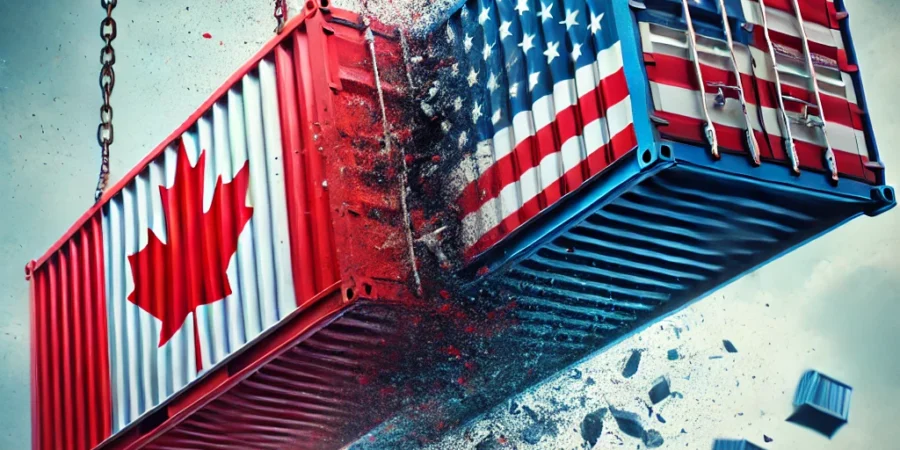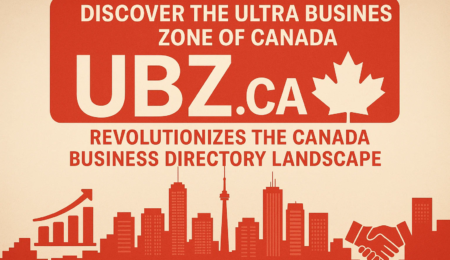As of March 17, 2025, Canada is grappling with the economic repercussions of U.S. President Donald Trump’s tariff policies, which impose a 25% tariff on most Canadian goods and a 10% tariff on energy resources. These measures, justified under the International Emergency Economic Powers Act (IEEPA) for national security reasons like illegal immigration and drug trafficking, threaten to disrupt the Canada-U.S. trade relationship, where the U.S. absorbs 75% of Canada’s exports. This report delves into the impact on Canadian people, government responses, and strategies for adaptation, emphasizing the human dimension of this economic challenge.
Economic Impact and Sectoral Effects
The tariffs, effective from February 2025 with some delays, have sparked significant concern. The Canadian Chamber of Commerce (Trump’s 25% Tariff Threat) estimates a 2.6% GDP contraction, costing CAD $78 billion annually, or roughly $1,900 per Canadian. This could push Canada into recession by mid-2025, as noted by TD Economics (TD Economics Report). Sectors like automotive, manufacturing, and agriculture are hit hardest, with the Bank of Canada (Bank of Canada Analysis) highlighting disruptions to supply chains, affecting employment and output.
For Canadian people, this translates to:
- Job Losses: Workers in export-dependent industries, such as automotive assembly in Ontario, face layoffs or reduced hours. The Canadian Steel Producers Association (Canada’s Retaliation) warned of similar impacts from past tariffs, noting the interdependence with the U.S.
- Higher Prices: Retaliatory tariffs on U.S. goods, including beer, wine, and appliances, could raise consumer costs, as outlined by the Department of Finance (Canada’s Tariff Response). This strains household budgets, especially for essentials.
- Economic Uncertainty: A slowdown may affect investments, consumer confidence, and housing markets, creating broader financial stress, as discussed by CIBC Thought Leadership (Trade Dependency).

Government Responses and Support Measures
The Canadian government has taken several steps to mitigate these effects, focusing on both economic retaliation and direct support for people:
- Retaliatory Tariffs: Canada imposed 25% tariffs on $155 billion of U.S. imports, targeting goods like orange juice, peanut butter, and vehicles, as announced by Prime Minister Justin Trudeau (CBC News Retaliation). This aims to pressure the U.S. but may increase prices for Canadians.
- Financial Aid for Businesses: A $6 billion aid package was launched to support businesses, with details provided by Labour Minister Steven MacKinnon (CBC News Support). This includes measures to help exporters reach new markets and maintain cash flow.
- Worker Support: Employment insurance rules have been relaxed, extending access to the Work-Sharing Program, allowing workers to receive partial benefits during reduced hours. Additionally, $1 billion in new financing through Farm Credit Canada supports the agriculture sector, crucial for rural communities (CFIB Support).
- Remission Process: A process for exceptional tariff relief is in place, helping businesses navigate the new trade environment, as noted by Doane Grant Thornton (Business Impact).
These measures aim to cushion the blow for Canadian people, but challenges persist, especially for those in affected sectors.
Public Reaction and Individual Actions
Canadian public reaction has been mixed, with widespread concern and calls for action. Provincial leaders like B.C. Premier David Eby have condemned the tariffs as an “unprecedented attack,” directing actions like removing American liquor from shelves (CBC News Reactions). Prime Minister Trudeau has warned of “difficult days,” emphasizing unity (BBC News Reaction), while opposition leader Pierre Poilievre advocates for tax cuts and border control to protect sovereignty (NBC News Politics).
For individual Canadians, adaptation is key:
- Support Local Businesses: Buying Canadian-made products, such as local produce or crafts, reduces reliance on U.S. goods and supports domestic jobs. Campaigns like “Buy Canadian” can shift consumer habits, as suggested by Trudeau’s calls for patriotism.
- Stay Informed: Keeping up-to-date with government programs, like the EI Work-Sharing Program or business aid, ensures access to support. Resources are available at Canada.ca.
- Career Diversification: Workers in affected sectors can explore retraining programs or alternative industries, leveraging government support for skill development.
- Community Engagement: Joining industry groups or community initiatives can provide support networks and share information, fostering resilience.
Long-term Strategies for Trade Diversification
To reduce dependence on the U.S., Canada must pursue long-term strategies, especially given the historical challenge of diversifying trade. The Export Diversification Strategy aims for 50% more overseas exports by 2025, leveraging free trade agreements like CPTPP (Trade Diversification Strategy) and CETA (CETA Overview). Strengthening ties with the EU, Japan, and emerging markets like India and Southeast Asia is crucial, as noted by the Asia Pacific Foundation (Diversification Efforts).
Additionally, Canada can:
- Build Domestic Supply Chains: Encourage vertical integration and local manufacturing to reduce reliance on U.S. inputs, as suggested by CIBC Thought Leadership (Trade Dependency).
- Invest in Innovation: Support new industries less vulnerable to U.S. tariffs, such as technology and green energy, to create jobs and diversify the economy.
- Diplomatic Engagement: Leverage the 2026 USMCA review to seek exemptions, framing Canada as a cooperative partner on border security, as discussed by Reuters (Canada’s Retaliation).
Conclusion and Forward-Looking Perspective
Trump’s tariffs present a formidable challenge, but with immediate relief measures, strategic retaliation, and long-term diversification, Canada can mitigate the damage. For Canadian people, the focus is on adapting through community support, staying informed, and embracing change. While the road ahead is rocky, with risks of recession and prolonged tensions, a unified and proactive approach will help navigate this crisis, ensuring a resilient future for all Canadians.
Read the UBZ blog.



